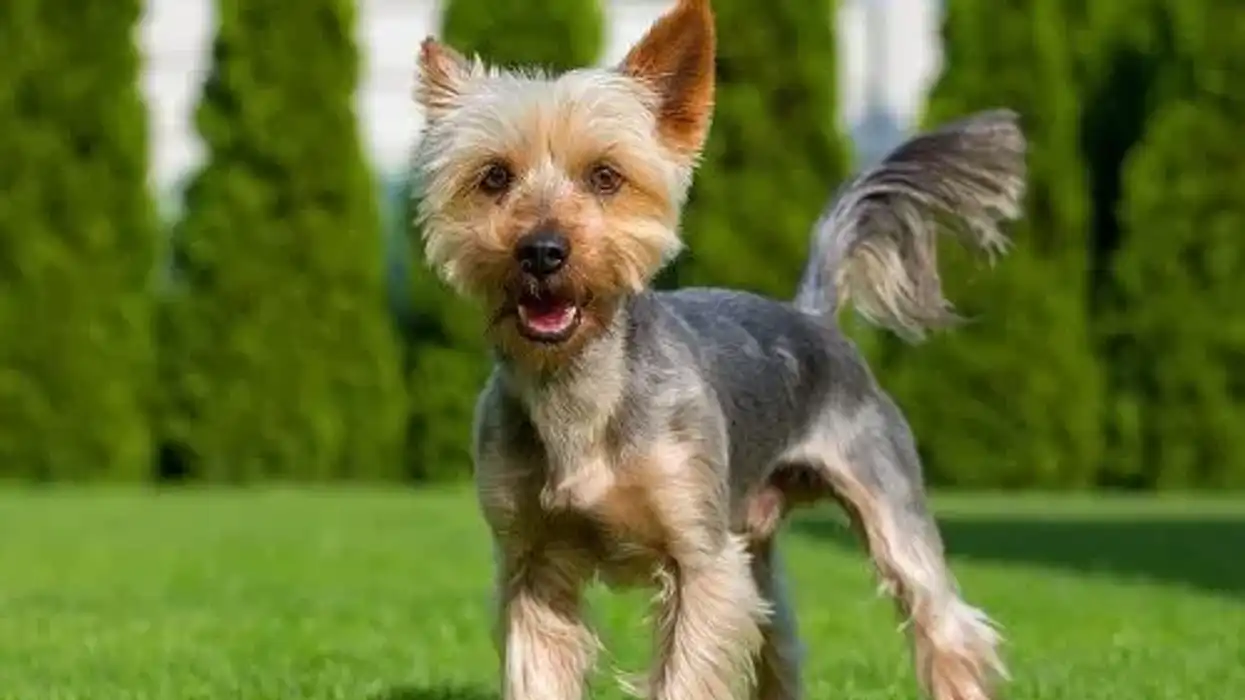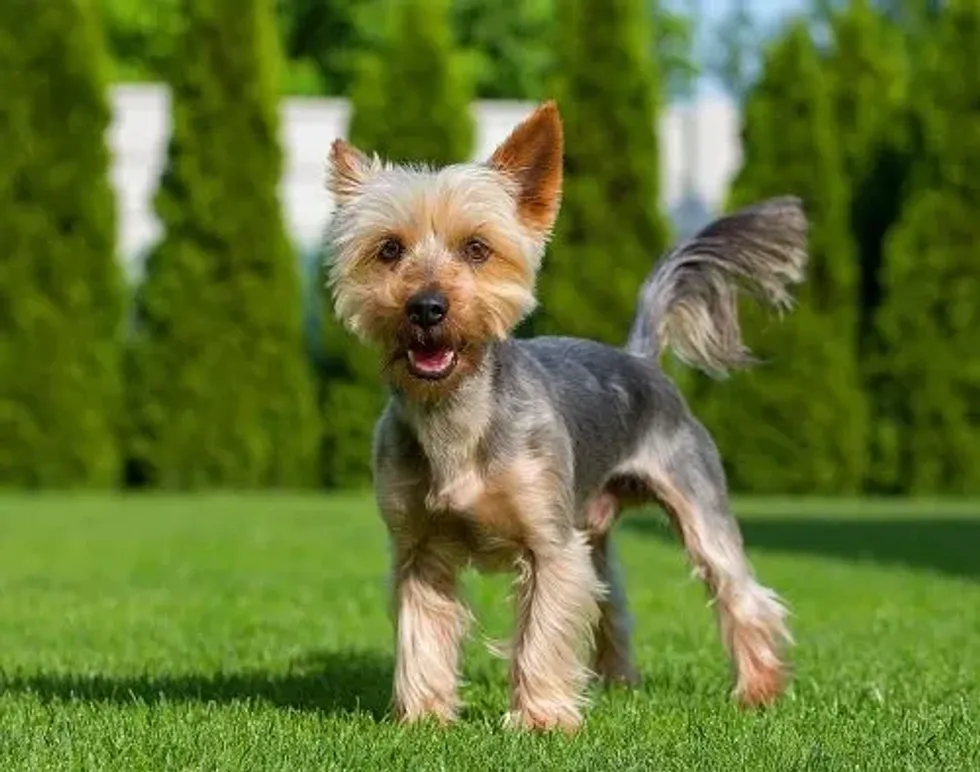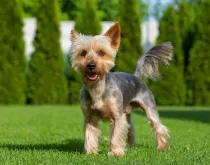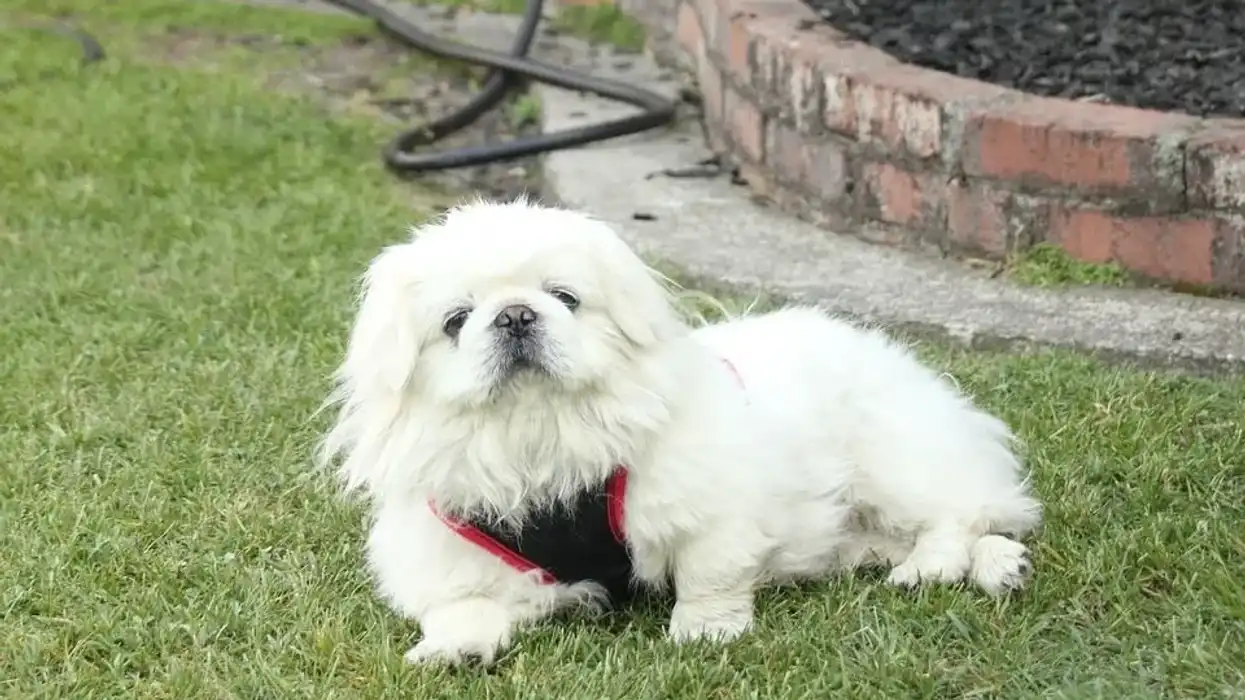Fun Silky Terrier Facts For Kids

Content
- What type of animal is a Silky Terrier?
- What class of animal does a Silky Terrier belong to?
- How many Silky Terriers are there in the world?
- Where does a Silky Terrier live?
- What is a Silky Terrier's habitat?
- Who do Silky Terriers live with?
- How long does a Silky Terrier live?
- How do they reproduce?
- What is their conservation status?
- What do Silky Terriers look like?
- How cute are they?
- How do they communicate?
- How big is a Silky Terrier?
- How fast can a Silky Terrier run?
- How much does a Silky Terrier weigh?
- What are their male and female names of the species?
- What would you call a baby Silky Terrier?
- What do they eat?
- Are they slobbery?
- Would they make a good pet?
- Did you know...
- Characteristics and health issues
- Getting your own Silky Terrier
Also called the Australian Silky Terrier, the Silky is a breed originally from Australia, but the ancestors of this breed are from Great Britain. Silky Terriers are tiny terriers and are also vermin hunters. Yes, that's right, these friendly Silky Terriers are famous for hunting snakes and rodents in Australia.
The Yorkshire Terrier and the Australian Terrier are two other breeds related to the Silky Terrier, which is a 19th century cross between these two breeds. It was first named the Sydney Silky and is now recognized by the American Kennel Club. In 1958, the Silky Terrier was grouped into the 'Toy' group by the Australian Kennel Club.
Silky Terriers are active and sharp-minded both indoors and outdoors. For their high energy levels, they have to be engaged in lots of activities and exercise. The Silky Terrier is blue and tan, sandy, or solid red in color.
They shed little to no hair and any dead hair from their coats can be removed by brushing. They are known to be a good companion, as they are playful and loyal. When outdoors, it is best for these small, hypoallergenic dogs to play within a fenced area.
Read on to learn more about the Silky Terrier, and check out our guide to the Cairn terrier and the bull terrier to learn about other terriers.
Silky Terrier Interesting Facts
What type of animal is a Silky Terrier?
The Silky Terrier is a small hunting toy dog. They were originally bred as companion dogs and most kennel clubs around the world have grouped this terrier into the toy section, except the Belgium National Kennel Club, which groups them as the smallest dogs in the terrier group.
These terriers are intelligent and fast learners, and they adapt well to traveling. A good amount of exercise will help them release their energy and helps them stay calm and healthy.
As they are so attentive, early training improves their health and helps them to grow into a well-behaved adult. They generally respond well to training, are agile, loyal, and friendly.
What class of animal does a Silky Terrier belong to?
The Silky Terrier belongs to the Mammalia class of mammals. They are one of many terrier breeds and are known for hunting down vermin in Australia.
How many Silky Terriers are there in the world?
This breed of terrier has been a popular dog since the 19th century. So, there are a great number of Silky Terriers around the world but the exact number is not currently known.
Where does a Silky Terrier live?
Silky Terriers live in homes and are great apartment dogs with the right training. They need daily exercise and interaction and these terriers also enjoy digging, so a fenced yard is an advantage.
What is a Silky Terrier's habitat?
The Silky Terrier originates from Sydney, Australia and hence they like to live in warmer climates. They are quite sensitive to cold weather. A Silky Terrier can live both in the countryside and in an apartment, but this terrier breed is not to be left alone for a long time.
Who do Silky Terriers live with?
Silky Terriers live with humans who can provide them with ample exercise. They are mischievous and can wander off looking for prey outside, so they need lots of attention. They excel at several dog sports too. Loneliness and boredom cause them to 'act out,' so they can not be left alone in a house for long periods of time.
How long does a Silky Terrier live?
These terriers live for up to 12 to 15 years. Yorkshire and Australian terriers both live longer than the Silky breed.
How do they reproduce?
A female Silky Terrier's pregnancy lasts for 60-64 days. The female attracts a male during her first part of the reproductive cycle called the proestrus stage, lasting for nine days. The next part of the cycle is called the estrus stage and it lasts for three to 11 days.
This is when the female is receptive to mate with a male. Diestrus is the third stage that occurs at around day 14 and during this time the female won't permit mating.
The last part is called the anestrus stage. This cycle occurs every six months and Silky Terriers are bred once a year. It is not healthy to breed this terrier more than once each year.
What is their conservation status?
Silky Terriers are cute dogs with big personalities and the real threat to these terriers is health issues. They can be prone to diabetes, obesity, and Legg-Perthes disease. Despite these risks, their conservation status is currently Least Concern.
Silky Terrier Fun Facts
What do Silky Terriers look like?
You could easily mistake this breed for an Australian or Yorkshire terrier. The Silky Terrier is a short-legged, fine-boned toy dog from the group of terrier dog breeds.
They are well-built with a fine bone structure, even though they are small. The primary colors on a terrier are gray, light and dark blue, and brown.
The different shades of blue that can be found in this breed e are silver-blue, slate-blue, or pigeon-blue and this terrier's fur is smooth, long, and shiny! Their small black almond-shaped eyes are quite close to each other and they have dark rims around their eyes.
This terrier also has spiky V-shaped ears, and its nose is black. With a stiff mouth, their teeth make a scissor-like bite.
Their height is less than their body length. The approximate length of this terrier's fur coat is 5-6 in (12-15 cm), but it is shorter on each leg.
Their strong head is wedge-shaped and the coat of hair on top of their head forms a cute top knot! They have a strong square muzzle and a broad chest. The fur on their back is parted in the middle and they have a small round cat-like foot.
These terriers have a laid-back shoulder and strong forelegs. Their hind legs don't appear heavy but they are strong and muscular.
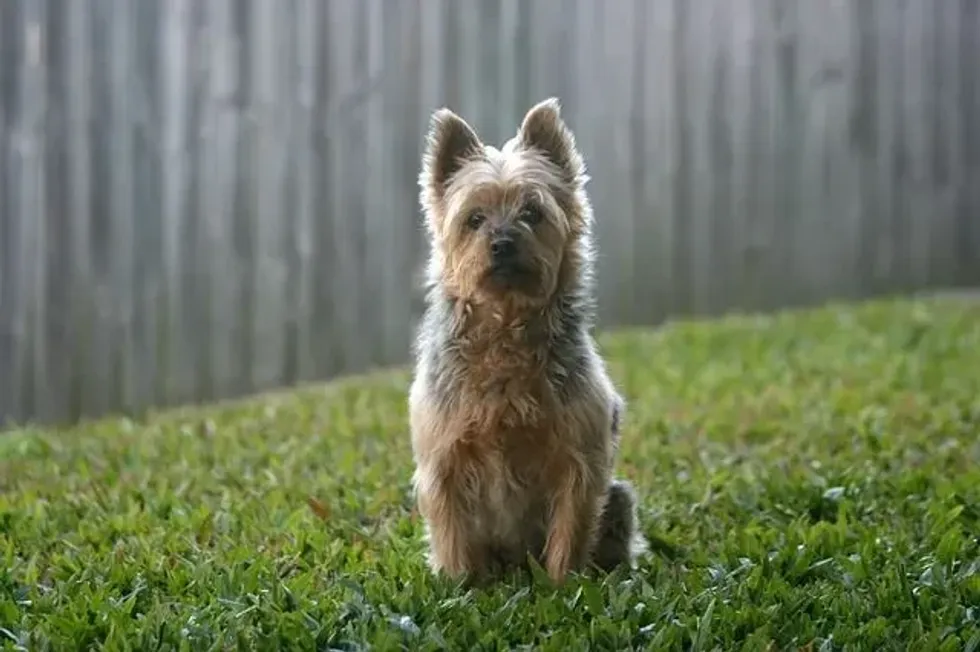
How cute are they?
They are small, fluffy, and easy to carry. Their small face is covered with a coat of fur that can be tied into a topknot, so we think that the Silky Terrier very cute!
How do they communicate?
This terrier breed is good at communication and its terrier temperament is quite easy to work with. However, they do have a tendency to bark when new people arrive in their home and they may also bark when they are approached by a bigger dog.
They also might bark to protect their owners if there are any changes in their environment. Primarily, they communicate with humans by touch.
They enjoy sitting on their owner's lap and they also communicate by the movement of their ears, howling, and by eye contact, just like most dogs. They have the tendency to bark when they come across small animals like rabbits and guinea pigs and will try to chase them off.
How big is a Silky Terrier?
The Silky Terrier breed is a toy breed of the terrier dog type. Their height is 23-26 cm (9.1-10.2 in) and they are slightly longer than they are tall.
This breed is slightly bigger than the Yorkshire terrier and smaller than the Australian terrier but they do have many features in common with the Australian terrier. They shed a little more than both Yorkshire terriers and Australian terriers.
How fast can a Silky Terrier run?
Silky Terriers are active runners even with their small bodies. The highest speed of a Silky Terrier recorded was 17.6 mph (28.3 kph).
How much does a Silky Terrier weigh?
The Silky Terrier's average weight is 8-12 lb (4-5 kg). They are slightly heavier than both Australian terriers and Yorkshire terriers and we can differentiate between the male and the female of this breed by their weight.
The weight of a male Silky Terrier breed is between 9-11 lb (4-5 kg) and the weight of a female is normally between 8-10 lb (3.6-4.5 kg).
What are their male and female names of the species?
A male Silky Terrier is called a 'dog' and a female is called a 'bitch'.
What would you call a baby Silky Terrier?
Baby Silky Terriers are called Silky Terrier puppies. Have you ever seen a Silky Terrier puppy?
What do they eat?
A Silky Terrier puppy diet includes nutritious dog food with high calcium and protein contents. This puppy has to be fed about one-eighth of a cup at a time, as they have a very small stomach.
An adult terrier can be fed one-quarter of a cup twice a day. Any extra food can cause health problems in this breed, including obesity. They have to be fed dry food to maintain their dental health and owners should avoid cooked food that is high in fat.
Are they slobbery?
No. This terrier is in a group of very minimal drooling pets. If your terrier drools it could be a sign of a health issue so it is best to get them checked over by a vet.
Would they make a good pet?
Yes, they make a good friendly pet and can be an ideal companion with the proper care and training. The Australian Silky Terrier is an apartment-friendly dog too.
However, the typical Silky Terrier temperament can be a little unpredictable and, if not trained properly, they can be nasty. This terrier is an active and intelligent pet so they need to be given lots of training when they are still puppies, to help them socialize.
Children in the house are to be introduced in the right manner without causing agitation or exciting the pet too much. With proper guidance, children can also play with a Silky Terrier.
Grooming is very important to maintain their good health. The Silky Terrier does not shed a lot of hair so, to avoid tangling, they need to be bathed every two weeks with a gentle shampoo.
They need to be brushed daily for about 10 minutes and their coat must be trimmed regularly. The Silky Terrier also needs regular trimming of its nails.
To maintain good oral hygiene, owners should clean their teeth routinely and feed them primarily dry food.
Daily exercises like walking, playing fetch, and indoor activities also improve their health. The Australian Silky Terrier is also a digger, so it is important to train a Silky Terrier dog to share their toys or food when they are young and not to destroy the house around them!
Did you know...
In the year 1955 the original name of this breed, Syndey Silky Terrier, was changed to Australian Silky Terrier.
The Silky Terrier dog breed has been bred with a West Highland white terrier, a poodle, and a Maltese to create three Silky Terrier mix-breeds called the Silkland terrier, the Poolky, and the Silkese, respectively.
McArthur Little from Australia was one of the earliest breeders of the Silky Terrier dog breed.
According to Silky Terrier history, this dog was originally bred to hunt down snakes and other dangerous creatures.
The Australian terrier and the Silky Terrier were not recognized as different breeds for many years.
Due to high demand, some breeders selectively breed even smaller terriers called Miniature Silky Terriers or Teacup Silky Terriers. This type of dog is just 5 in (12.7 cm) tall and its weight is 5 lb (2.2 kgs).
Due to their alert and attentive behavior and their small size they are also nicknamed 'small Napoleon' dogs.
When it comes to Silky Terrier vs Yorkie dogs, a fully grown Yorkie dog is 8 in (20.32 cm) long and weighs 7 lb (3.2 kg), making it smaller than a Silky Terrier.
Characteristics and health issues
The Silky Terrier dog breed is prone to the small dog disease called tracheal collapse. Factors that can intensify this disease are obesity, dust, and a lack of exercise.
The hereditary slipping kneecap disease that this breed can also suffer from is called patellar luxation. This a disease that causes displacement of the kneecap in a dog. It is best to not allow your pet to jump from high surfaces in order to protect the health of their knees.
Legg-Perthes disease is the wearing down of the femur bone in the hind leg. The exact cause of this disease is yet to be discovered.
When this dog breed is not able to produce enough insulin they suffer from diabetes. Signs of diabetes in Silky Terriers are acute onset blindness, excessive thirst, increased urination, and weight loss.
Several factors can cause epilepsy in this breed of dogs, including brain trauma and tumors, toxins, kidney failure, and liver disease. Sometimes terrier dog breeds suffer from two types of Crushing's disease, the syndrome, and the disease. A tumor in the adrenal gland causes this syndrome.
Finally, this breed is also prone to allergies like many other dog breeds. These allergies are both food and skin-related.
Signs of allergies in a dog are stomach distress, respiratory issues, and hives. Owners should also take precautions with their own shampoo or laundry detergents to prevent contact allergies. With regular checkups, it easy to detect these health problems at an early stage and get the right treatment.
Getting your own Silky Terrier
When buying a pet Silky Terrier, it is important to get plenty of information on the parent breed's health conditions from a professional breeder.
It is advisable to ask for certificates from the Canine Eye Registry Foundation (CERF) and the Orthopedic Foundation of America (OFA). A Silky Terrier puppy that is purebred with good health conditions costs around $1500 but you can also look out for a Silky Terrier rescue dog from those that are put up for adoption and foster care.
Prospective puppy owners can also browse the Silky Terrier Club of America for a list of breeders who meet rigorous standards.
Here at Kidadl, we have carefully created lots of interesting family-friendly animal facts for everyone to discover! Learn more about some other mammals including the American pit bull terrier, or the border terrier.
You can even occupy yourself at home by drawing one on our Silky terrier coloring pages.
We Want Your Photos!
More for You
See All
Bachelor of Engineering specializing in Aeronautical/Aerospace Technology, Master of Business Administration specializing in Management

Arpitha RajendraBachelor of Engineering specializing in Aeronautical/Aerospace Technology, Master of Business Administration specializing in Management
With a background in Aeronautical Engineering and practical experience in various technical areas, Arpitha is a valuable member of the Kidadl content writing team. She did her Bachelor's degree in Engineering, specializing in Aeronautical Engineering, at Nitte Meenakshi Institute of Technology in 2020. Arpitha has honed her skills through her work with leading companies in Bangalore, where she contributed to several noteworthy projects, including the development of high-performance aircraft using morphing technology and the analysis of crack propagation using Abaqus XFEM.
Bachelor of Arts specializing in English Language and Literature, Master of Arts specializing in Philosophy and Religious Studies

Tehil DavidBachelor of Arts specializing in English Language and Literature, Master of Arts specializing in Philosophy and Religious Studies
Tehil David Singh is a fact checker with a Bachelor's degree in English literature from St.Xavier's College, Palayamkottai, and a Master's degree in Philosophy, and Religion from Madurai Kamaraj University. He has a passion for writing and hopes to become a story writer in the future. Tehil has previously interned in content writing and has been a content creator for the last three years. In his personal life, he enjoys singing, songwriting, performing, and writing stories.
Disclaimer
1) Kidadl is independent and to make our service free to you the reader we are supported by advertising. We hope you love our recommendations for products and services! What we suggest is selected independently by the Kidadl team. If you purchase using the Buy Now button we may earn a small commission. This does not influence our choices. Prices are correct and items are available at the time the article was published but we cannot guarantee that on the time of reading. Please note that Kidadl is a participant in the Amazon Services LLC Associates Program, an affiliate advertising program designed to provide a means for sites to earn advertising fees by advertising and linking to Amazon. We also link to other websites, but are not responsible for their content.
2) At Kidadl, we strive to recommend the very best activities and events. We will always aim to give you accurate information at the date of publication - however, information does change, so it’s important you do your own research, double-check and make the decision that is right for your family. We recognise that not all activities and ideas are appropriate for all children and families or in all circumstances. Our recommended activities are based on age but these are a guide. We recommend that these ideas are used as inspiration, that ideas are undertaken with appropriate adult supervision, and that each adult uses their own discretion and knowledge of their children to consider the safety and suitability. Kidadl cannot accept liability for the execution of these ideas, and parental supervision is advised at all times, as safety is paramount. Anyone using the information provided by Kidadl does so at their own risk and we can not accept liability if things go wrong.
3) Because we are an educational resource, we have quotes and facts about a range of historical and modern figures. We do not endorse the actions of or rhetoric of all the people included in these collections, but we think they are important for growing minds to learn about under the guidance of parents or guardians.
